Key Takeaways
- Top CDPs in 2025 unify customer data, enabling personalized experiences and AI-driven insights across all channels.
- Real-time activation, seamless integrations, and robust data governance are key features driving CDP effectiveness.
- Analyst recognition and customer ratings highlight the market-leading platforms that deliver measurable business growth.
In the rapidly evolving digital landscape of 2025, businesses are increasingly realizing that understanding their customers is no longer optional—it is a strategic imperative. Customer Data Platforms (CDPs) have emerged as a cornerstone technology for organizations seeking to unify, analyze, and activate customer data across multiple touchpoints. Unlike traditional marketing tools, CDPs provide a single, coherent view of each customer, aggregating information from diverse sources such as transactional systems, websites, mobile applications, email campaigns, and offline interactions. This consolidated view enables businesses to deliver personalized, timely, and highly relevant experiences that drive engagement, loyalty, and revenue growth.

The importance of CDPs in modern marketing strategies cannot be overstated. In an era where consumers demand hyper-personalized interactions and seamless omnichannel experiences, CDPs serve as the critical infrastructure that empowers businesses to meet these expectations. By consolidating first-party data into a persistent customer profile, CDPs allow marketers to craft data-driven campaigns, optimize customer journeys, and make informed decisions grounded in actionable insights. As artificial intelligence and machine learning continue to advance, these platforms now offer predictive analytics, real-time decision-making, and automation capabilities, taking customer engagement to unprecedented levels of sophistication.
The CDP market has experienced remarkable growth and transformation over recent years. Initially focused on basic data unification, today’s top CDPs in 2025 integrate AI-driven personalization, real-time data processing, advanced segmentation, and seamless cross-channel orchestration. Leading platforms such as Adobe Real-Time CDP, Salesforce Data Cloud, Twilio Segment, Optimove, and Treasure Data have set new benchmarks by enabling businesses to translate vast amounts of customer data into measurable business outcomes. These platforms are recognized not only for their ability to centralize data but also for their capabilities in predictive insights, automated workflows, and dynamic customer engagement.
In addition to technical capabilities, CDPs play a crucial role in ensuring compliance with increasingly stringent data privacy regulations such as GDPR, CCPA, and other emerging legislation. By providing robust consent management, secure data governance, and transparent tracking of customer interactions, CDPs allow businesses to balance personalization with privacy, fostering trust and long-term relationships with their audiences.
This in-depth analysis of the top 11 Customer Data Platforms in 2025 will explore the unique features, strengths, pricing models, and industry applications of each platform. It will also examine the market trends shaping the CDP landscape, including AI-powered personalization, real-time data activation, composable architectures, and industry-specific solutions. Whether you are a marketer, data strategist, or business leader, this comprehensive guide aims to provide valuable insights to help you navigate the complex CDP ecosystem and select the platform that aligns with your organizational goals, ensuring optimal customer experiences and sustained growth in 2025.
Before we venture further into this article, we would like to share who we are and what we do.
About 9cv9
9cv9 is a business tech startup based in Singapore and Asia, with a strong presence all over the world.
With over nine years of startup and business experience, and being highly involved in connecting with thousands of companies and startups, the 9cv9 team has listed some important learning points in this overview of The Top 11 Customer Data Platforms in 2025.
If your company needs recruitment and headhunting services to hire top-quality employees, you can use 9cv9 headhunting and recruitment services to hire top talents and candidates. Find out more here, or send over an email to [email protected].
Or just post 1 free job posting here at 9cv9 Hiring Portal in under 10 minutes.
Top 11 Customer Data Platforms in 2025: An In-Depth Analysis
- Insider
- Bloomreach
- Salesforce Marketing Cloud CDP / Salesforce Data Cloud
- Emarsys
- Adobe Real-Time CDP
- Optimove
- ActionIQ
- Twilio Segment
- Tealium
- mParticle
- Treasure Data
1. Insider
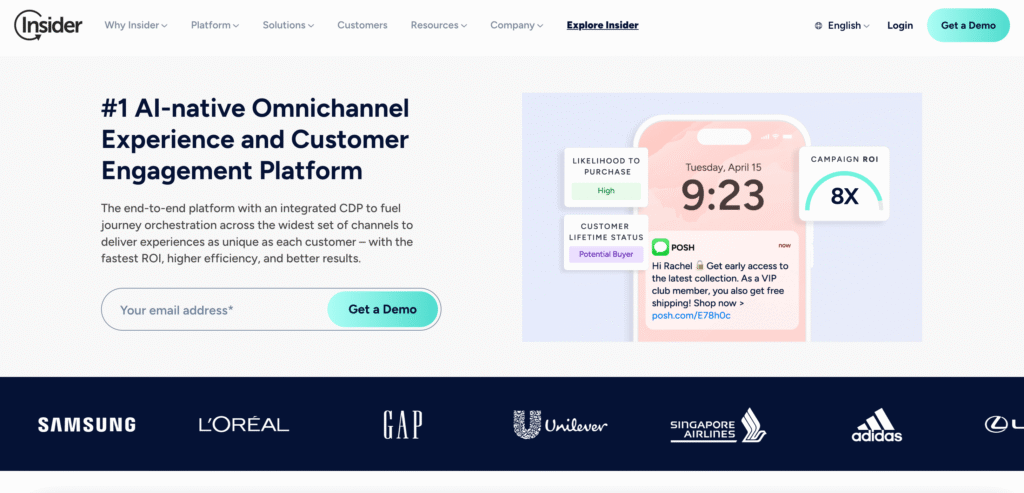
Overview of Insider as a CDP
- Insider is distinguished in the Customer Data Platform (CDP) landscape for its capability to consolidate diverse customer data into a single, easily accessible repository.
- The platform enables brands to make actionable insights available across websites, mobile applications, and multiple messaging channels, ensuring a seamless omnichannel experience.
- Insider’s design emphasizes user-centric convenience, which has earned it top rankings on G2 for both ease of use and administrative simplicity.
Advanced Features and Functionalities
- Agent One™: Automates customer interactions, enhancing efficiency and consistency in communication across all digital touchpoints.
- Sirius AI™: Provides predictive analytics and intelligent insights, empowering brands to make data-driven marketing and operational decisions.
- Unified Customer Profiles: Insider aggregates fragmented customer data to generate accurate, 360-degree profiles, breaking down traditional data silos.
Impact on Leading Brands
- Global brands including AVON, Samsung, and Toyota have adopted Insider to streamline data management and optimize customer engagement.
- By leveraging unified customer profiles, these companies have been able to:
- Increase revenue through more targeted campaigns
- Enhance average order value (AOV) by tailoring product recommendations
- Improve customer lifetime value (LTV) through personalized, omnichannel experiences
Omnichannel Support
- Insider facilitates engagement across a broad spectrum of touchpoints, including:
- Websites and mobile applications
- Push notifications, email, SMS, and RCS messaging
- Popular messaging platforms such as WhatsApp and Facebook Messenger
Market Recognition and Validation
- Consistent accolades from G2 underscore Insider’s credibility as a leading CDP solution.
- While precise market share figures are not disclosed, the platform’s strong industry presence is further validated by a substantial $500 million Series E funding round, signaling significant investor confidence in its continued growth trajectory.
Investment and Pricing
- Insider’s pricing model is customized based on enterprise requirements, ensuring scalable solutions for businesses of all sizes.
Comparative Advantage Matrix
| Feature / Capability | Insider | Competitor A | Competitor B |
|---|---|---|---|
| Unified Customer Profiles | High | Medium | Medium |
| AI-Driven Insights | Sirius AI™ | Standard AI | Limited AI |
| Omnichannel Integration | Full | Partial | Partial |
| Ease of Use | Top-Rated | Moderate | Low |
| Automation of Interactions | Agent One™ | Limited | Minimal |
Performance Metrics and Business Impact
- Implementation of Insider typically results in measurable improvements in key performance indicators, such as:
- Conversion rate uplift through personalized campaigns
- Enhanced retention and repeat purchase rates
- Streamlined marketing operations with automated workflows
Conclusion
- Insider exemplifies why it is recognized among the top 11 Customer Data Platforms in 2025.
- Its combination of advanced AI capabilities, comprehensive omnichannel integration, and strong industry validation positions it as a strategic choice for enterprises seeking to maximize the value of their customer data.
2. Bloomreach

Overview of Bloomreach as a CDP
- Bloomreach stands out as a premier Customer Data Platform (CDP) that combines AI-driven personalization with robust analytics to deliver seamless customer experiences.
- Its primary focus is on understanding customer behavior across the entire journey, enabling brands to make highly informed, data-driven decisions.
- The platform’s design supports integration across multiple touchpoints, ensuring consistent engagement across web, mobile, and email channels.
Advanced AI-Powered Functionalities
- Autonomous Search: Enhances product discovery by dynamically understanding customer intent and behavior.
- Conversational Shopping: Facilitates interactive, real-time engagement, enabling brands to deliver personalized recommendations and shopping assistance.
- Autonomous Marketing: Automates marketing workflows while optimizing campaigns based on AI-generated insights.
- Predictive Analytics: Provides detailed insights into customer preferences and engagement patterns, supporting targeted marketing initiatives.
Global Adoption and Brand Impact
- Over 1,400 global brands leverage Bloomreach to enhance customer experiences and drive higher revenue.
- The platform empowers companies to:
- Deliver personalized experiences that increase conversion rates
- Optimize cross-channel engagement for greater customer retention
- Align marketing and sales strategies with actionable customer insights
Recognition and Industry Validation
- Bloomreach’s excellence is recognized across leading industry benchmarks:
- Positioned as a Leader in the 2024 Gartner Magic Quadrant for Search and Product Discovery
- Rated a Strong Performer in The Forrester Wave: Cross-Channel Marketing Hubs, Q4 2024
- Customer feedback on Bloomreach Engagement, a core component of the platform, demonstrates high satisfaction and positive ratings.
Pricing and Enterprise Integration
- While full pricing details are provided upon request, the BigCommerce integration begins at $4,000 per month, reflecting its enterprise-grade capabilities.
- The platform’s flexible pricing and scalability make it suitable for mid-market to large enterprises seeking sophisticated personalization strategies.
Comparative Feature Matrix
| Feature / Capability | Bloomreach | Competitor A | Competitor B |
|---|---|---|---|
| AI-Powered Personalization | Advanced | Moderate | Basic |
| Omnichannel Integration | Full | Partial | Partial |
| Autonomous Marketing | Yes | Limited | No |
| Predictive Analytics | Detailed | Basic | Minimal |
| Customer Engagement Insights | Comprehensive | Moderate | Limited |
Business Impact Metrics
- Companies implementing Bloomreach typically report measurable improvements in:
- Revenue growth through tailored product recommendations
- Customer retention via consistent, personalized omnichannel experiences
- Efficiency in marketing operations due to automated workflows
Conclusion
- Bloomreach exemplifies why it ranks among the top 11 Customer Data Platforms in 2025.
- Its combination of advanced AI functionalities, comprehensive analytics, and proven industry recognition positions it as a strategic solution for enterprises seeking to optimize customer engagement and drive revenue growth.
3. Salesforce Marketing Cloud CDP / Salesforce Data Cloud
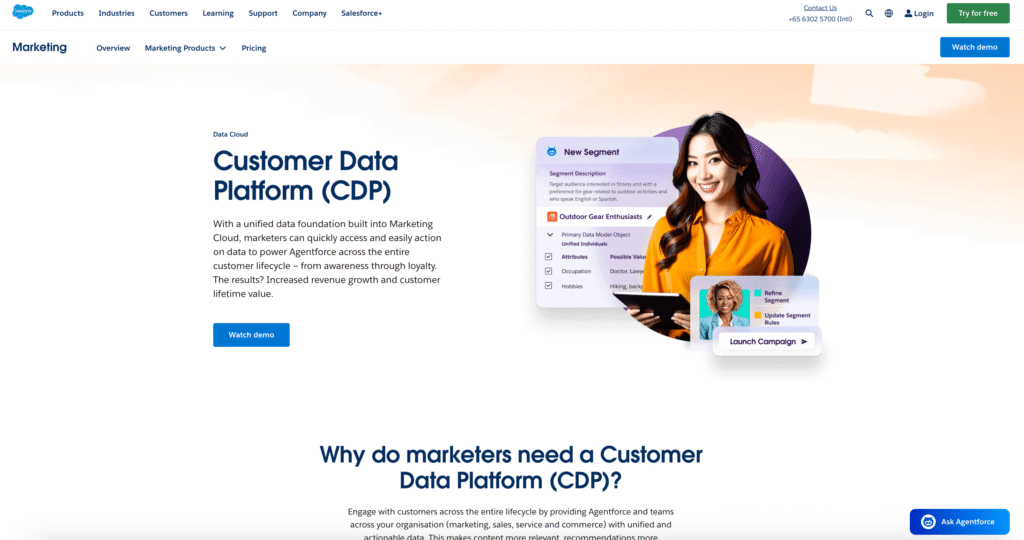
Overview of Salesforce Data Cloud as a CDP
- Salesforce Data Cloud, formerly known as Salesforce Marketing Cloud CDP, is recognized for its ability to unify customer data from diverse sources into comprehensive, single customer profiles.
- By aggregating transactional, behavioral, and demographic data, the platform provides brands with a 360-degree view of their customers, enabling highly informed decision-making.
- The solution emphasizes both operational efficiency and strategic insight, positioning Salesforce Data Cloud as a critical tool for enterprises seeking to maximize customer engagement and ROI.
Advanced AI and Predictive Capabilities
- Salesforce Einstein Integration: Delivers AI-powered insights, predictive analytics, and recommendations that guide marketers in optimizing campaigns and anticipating customer needs.
- Journey Builder: Automates complex cross-channel customer journeys while enabling deep personalization at every stage of engagement.
- Predictive Modeling: Supports identification of high-value customers, potential churn risks, and optimal marketing strategies for retention and revenue growth.
Seamless Platform Integration
- Salesforce Data Cloud’s deep integration with the broader Salesforce ecosystem, including CRM, Sales Cloud, and Service Cloud, ensures a unified, enterprise-wide approach to customer data management.
- This connectivity allows businesses to leverage historical customer data, sales interactions, and service histories to deliver cohesive and relevant experiences across touchpoints.
Recognition and Market Validation
- Recognized as a Leader in the Gartner Magic Quadrant for Customer Data Platforms for the second consecutive year.
- Ranked as a Leader in The Forrester Wave: Customer Data Platforms for B2C, Q3 2024, highlighting its robust capabilities for business-to-consumer applications.
- High customer satisfaction is evident, with a 4.4 out of 5 rating on Gartner Peer Insights, reflecting positive user feedback regarding usability, functionality, and support.
Adoption and Revenue Impact
- In fiscal year 2025, Salesforce Data Cloud & AI achieved an annual recurring revenue of $900 million, marking a 120% increase year-over-year, demonstrating strong adoption and enterprise trust.
- The platform enables organizations to:
- Enhance customer lifetime value through personalized experiences
- Improve conversion rates via targeted, predictive campaigns
- Streamline marketing operations through automation and data-driven decision-making
Pricing and Deployment Flexibility
- Salesforce Data Cloud employs a consumption-based pricing model, offering scalable packages tailored to enterprise requirements.
- Pricing is generally provided upon request, accommodating businesses of varying sizes and marketing objectives.
Comparative Feature Matrix
| Feature / Capability | Salesforce Data Cloud | Competitor A | Competitor B |
|---|---|---|---|
| Unified Customer Profiles | Comprehensive | Moderate | Limited |
| AI-Powered Predictive Insights | Salesforce Einstein | Basic AI | Minimal AI |
| Cross-Channel Journey Automation | Journey Builder | Limited | Partial |
| CRM Integration | Full Salesforce Suite | Partial | None |
| Customer Satisfaction | 4.4/5 (Gartner Peer Insights) | 3.8/5 | 3.5/5 |
Performance and Business Impact Metrics
- Adoption of Salesforce Data Cloud typically results in measurable improvements, including:
- Increased engagement rates and conversion through predictive personalization
- Higher retention and loyalty from data-driven customer journeys
- Operational efficiency from automation and unified data access
Conclusion
- Salesforce Data Cloud’s advanced AI capabilities, cross-channel automation, and deep integration with the Salesforce ecosystem make it a standout among the top 11 Customer Data Platforms in 2025.
- Its industry recognition, substantial revenue growth, and consistently positive user feedback reinforce its position as a leading solution for enterprises aiming to transform customer engagement and maximize marketing effectiveness.
4. Emarsys
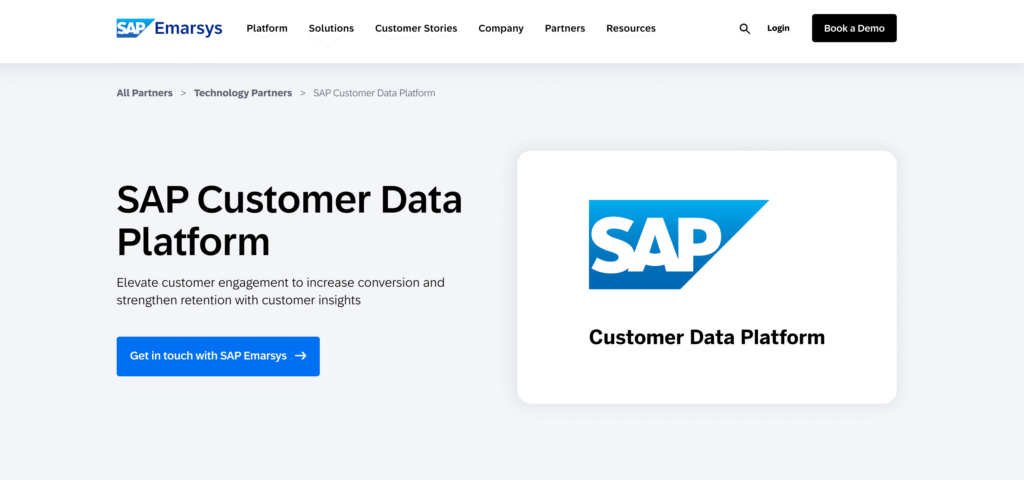
Overview of Emarsys as a CDP
- Emarsys is recognized as a leading omnichannel customer engagement and data platform, positioned among the top 11 Customer Data Platforms in 2025 due to its robust ability to unify data and power personalized interactions.
- The platform is engineered to collect, harmonize, and activate customer information from multiple marketing channels, giving businesses a consolidated view of their audiences.
- Its focus lies in transforming raw customer data into actionable insights, enabling enterprises to refine outreach strategies and maximize campaign effectiveness.
Core Features and Functionalities
- Omnichannel Data Integration: Pulls customer data seamlessly from diverse sources, including email, web, mobile, and social channels.
- AI-Optimized Data Collection: Employs artificial intelligence to refine data accuracy and generate predictive insights for more informed marketing decisions.
- A/B Testing Capabilities: Provides marketers with experimentation tools to test campaigns and optimize outcomes based on real-world performance.
- Marketing Automation: Streamlines repetitive workflows, ensuring timely and relevant customer communication.
- Third-Party Tool Integration: Easily connects with external platforms to extend functionality and enhance customer engagement strategies.
Why Enterprises Choose Emarsys
- Businesses leveraging Emarsys benefit from its ability to:
- Eliminate fragmented data silos by centralizing multi-channel information
- Deliver personalized campaigns tailored to individual customer journeys
- Improve conversion rates and customer retention through targeted interactions
- Reduce manual workloads with advanced automation, freeing resources for strategic planning
Market Recognition and Positioning
- Inclusion in multiple rankings, such as the Top 11 CDPs of 2025 and the Top 10 CDP Platforms, highlights Emarsys’s relevance and credibility in the competitive CDP landscape.
- Its continued recognition suggests broad adoption and market trust, even without publicly available customer review aggregates or disclosed market share figures.
Pricing and Accessibility
- Pricing for Emarsys is provided upon request, reflecting its flexible deployment models tailored to diverse business requirements.
- This approach ensures scalability, making it suitable for both mid-market organizations and larger enterprises seeking advanced personalization solutions.
Comparative Feature Matrix
| Feature / Capability | Emarsys | Competitor A | Competitor B |
|---|---|---|---|
| Omnichannel Data Integration | Advanced | Moderate | Limited |
| AI-Powered Insights | Yes | Partial | Minimal |
| Marketing Automation | Comprehensive | Moderate | Basic |
| Third-Party Integration | Seamless | Limited | Partial |
| A/B Testing Tools | Built-In | Limited | Not Available |
Business Impact Metrics
- Companies utilizing Emarsys often experience:
- Enhanced campaign performance through data-driven optimization
- Higher revenue generation from targeted personalization strategies
- Greater marketing efficiency with reduced manual processes
- Stronger customer loyalty from cohesive, omnichannel engagement
Conclusion
- Emarsys secures its place as one of the top 11 Customer Data Platforms in 2025 by combining omnichannel data unification, AI-powered insights, and advanced automation.
- Its ability to empower businesses with actionable customer intelligence makes it a strategic choice for enterprises aiming to deliver meaningful, personalized experiences at scale.
5. Adobe Real-Time CDP

Overview of Adobe Real-Time CDP
- Adobe Real-Time CDP, built on the Adobe Experience Platform, is designed to unify and activate customer data with precision, enabling enterprises to deliver instant, contextually relevant personalization across every channel.
- Unlike traditional CDPs, Adobe emphasizes real-time insights, ensuring that businesses can respond to customer behaviors and preferences as they occur.
- Its ability to merge online and offline data into comprehensive profiles positions it as one of the most versatile solutions in the global CDP market.
AI and Predictive Intelligence with Adobe Sensei
- Adobe Sensei AI Integration: Powers advanced analytics, delivering predictive insights that help organizations anticipate customer needs and optimize marketing strategies.
- Real-Time Decisioning: Ensures brands can adapt campaigns instantly based on live data signals.
- Predictive Modeling: Identifies customer segments most likely to convert, churn, or engage, allowing for proactive campaign planning.
Omnichannel Campaign Execution
- Adobe Real-Time CDP allows businesses to deploy personalized campaigns across multiple touchpoints, including:
- Websites and mobile applications
- Email and social media platforms
- Paid media, offline channels, and partner ecosystems
- This seamless execution supports consistent brand experiences and drives higher customer satisfaction.
Market Recognition and Analyst Validation
- Positioned as a Visionary in the 2025 Gartner Magic Quadrant for Customer Data Platforms, reflecting its innovation and strong market potential.
- Recognized as a Leader in The Forrester Wave: Customer Data Platforms for B2C, Q3 2024, highlighting its strength in consumer-focused personalization.
- Holds an average 4.3 out of 5 rating on Gartner Peer Insights, demonstrating strong customer confidence and adoption.
Strategic Editions and Pricing Flexibility
- Adobe Real-Time CDP is available in three tailored editions:
- B2C Edition: Focused on high-scale consumer engagement and personalization.
- B2B Edition: Designed for account-based marketing and enterprise client management.
- B2P Edition: Merges business and consumer data, enabling organizations to address both audiences seamlessly.
- Pricing is determined by the number of customer profiles managed, ensuring scalability and flexibility for enterprises of all sizes.
Integration Ecosystem
- The platform connects natively with Adobe’s suite of products, such as Adobe Analytics, Adobe Target, and Adobe Campaign.
- It also integrates with non-Adobe systems, providing broad data connectivity that eliminates silos and supports a unified digital marketing strategy.
Comparative Feature Matrix
| Feature / Capability | Adobe Real-Time CDP | Competitor A | Competitor B |
|---|---|---|---|
| Real-Time Customer Insights | Advanced | Limited | Moderate |
| AI-Powered Predictive Analytics | Adobe Sensei | Basic AI | Partial AI |
| Omnichannel Personalization | Full Integration | Partial | Limited |
| Industry Recognition | Visionary (Gartner), Leader (Forrester) | Strong Performer | Niche Player |
| Customer Ratings | 4.3/5 (Peer Insights) | 3.9/5 | 3.7/5 |
Business Impact and Market Growth
- In 2024, the U.S. predictive analytics segment held the largest market share in CDPs, a trend in which Adobe Real-Time CDP plays a pivotal role by offering enterprises highly advanced predictive modeling capabilities.
- Organizations adopting Adobe Real-Time CDP typically achieve:
- Higher marketing ROI through data-driven personalization
- Increased customer lifetime value with predictive retention campaigns
- Enhanced operational efficiency from real-time, automated decision-making
Conclusion
- Adobe Real-Time CDP distinguishes itself among the top 11 Customer Data Platforms in 2025 by merging real-time intelligence with deep personalization capabilities.
- Its AI-powered insights, flexible editions for different business models, and seamless integration within and beyond the Adobe ecosystem make it a strategic choice for enterprises seeking to deliver truly customer-centric engagement at scale.
6. Optimove
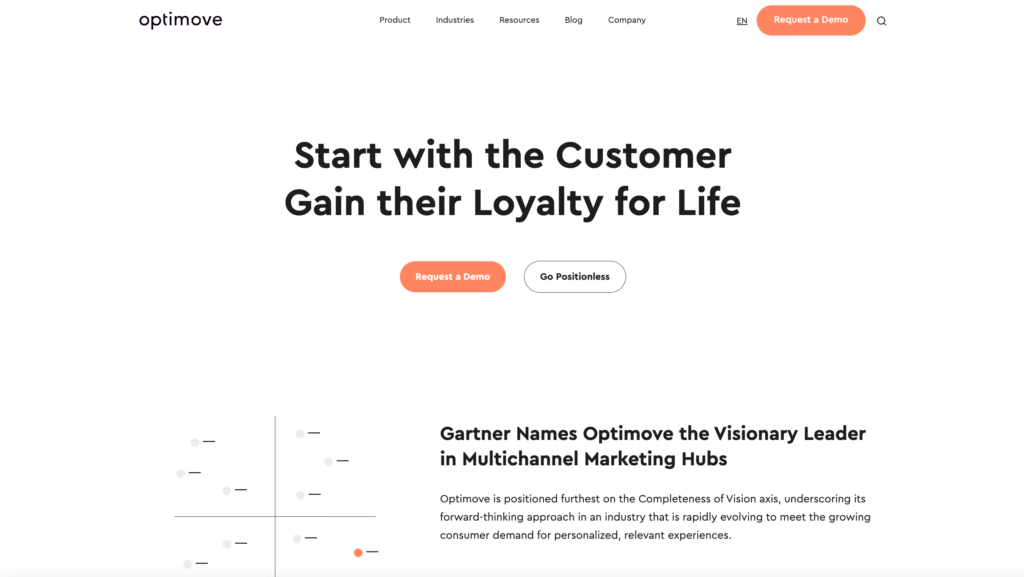
Advanced AI-Powered Customer Retention Capabilities
- Optimove stands out in the CDP landscape as a platform that places customer retention and long-term engagement at the forefront.
- Unlike conventional data platforms that primarily focus on acquisition, Optimove integrates artificial intelligence and predictive analytics to ensure businesses strengthen loyalty and lifetime value.
- The system creates individualized retention strategies by analyzing historical behaviors, purchase trends, and engagement levels to predict future actions with a high degree of accuracy.
- This proactive approach enables brands to not only reduce churn but also to maximize revenue through repeat purchases and stronger customer relationships.
Real-Time Customer Profiles and Predictive Insights
- Provides businesses with a 360-degree, real-time customer view, ensuring that every interaction is based on up-to-date behavioral and transactional data.
- Predictive models built into the platform assist companies in forecasting customer needs before they arise, facilitating more relevant campaigns and communications.
- Optimove’s analytics dashboards are fully customizable, giving marketing teams the flexibility to visualize complex customer data and translate it into actionable strategies.
Positionless Marketing: A Revolutionary Approach
- CEO Pini Yakuel emphasizes a concept known as “positionless marketing,” empowering marketing teams with autonomy by eliminating operational bottlenecks.
- This approach allows marketers to independently design, launch, and optimize campaigns without constant reliance on IT or data science teams.
- The result is faster campaign deployment, reduced departmental silos, and a more agile marketing ecosystem capable of responding quickly to changing customer demands.
Industry Recognition and Market Validation
- Optimove was recognized by Gartner as a Visionary Leader in the 2024 Magic Quadrant for Multichannel Marketing Hubs, highlighting its innovation and forward-thinking approach.
- It received a composite score of 7.1 out of 10 from SoftwareReviews, indicating strong performance in customer satisfaction, functionality, and overall business impact.
- Trusted by more than 500 global brands, Optimove has proven itself as a reliable solution capable of scaling across industries including retail, finance, gaming, and e-commerce.
Seamless Integration with Marketing Ecosystems
- Designed to integrate with a wide range of campaign management systems such as:
- Email marketing platforms
- Mobile push notification systems
- Web and app personalization tools
- This seamless integration ensures businesses can execute omnichannel campaigns without disruption, leading to unified and consistent customer experiences.
Pricing Model and Accessibility
- The platform’s pricing is structured around the number of monthly active customers, offering a scalable solution for businesses of different sizes.
- This model ensures cost efficiency, as companies pay in proportion to the actual value derived from customer interactions.
Comparative Evaluation: Optimove’s Strengths in 2025
| Feature Category | Optimove Strengths | Why It Matters |
|---|---|---|
| Customer Retention | AI-driven predictive retention models | Maximizes customer lifetime value and reduces churn |
| Customer Profiles | Real-time 360-degree customer view | Ensures data accuracy for timely and personalized campaigns |
| Marketing Autonomy | “Positionless marketing” strategy | Empowers marketers, reduces bottlenecks, and increases campaign agility |
| Recognition | Visionary Leader in Gartner’s 2024 Magic Quadrant | Reinforces credibility and innovation leadership |
| Integration Capabilities | Supports email, mobile push, web personalization, and campaign management systems | Enables smooth execution of omnichannel campaigns |
| Pricing Model | Based on monthly active customers | Offers scalability and cost-effectiveness for businesses at different stages |
Why Optimove is a Leading Choice in 2025
- Optimove is not just a CDP; it is a strategic growth partner that empowers companies to shift focus from transactional marketing to long-term relationship management.
- Its emphasis on AI-driven retention, predictive intelligence, and marketing independence positions it as one of the most forward-looking CDPs in 2025.
- With recognition from major industry analysts, high user adoption, and proven impact across diverse industries, Optimove has secured its place among the top 11 customer data platforms shaping the future of customer engagement.
7. ActionIQ
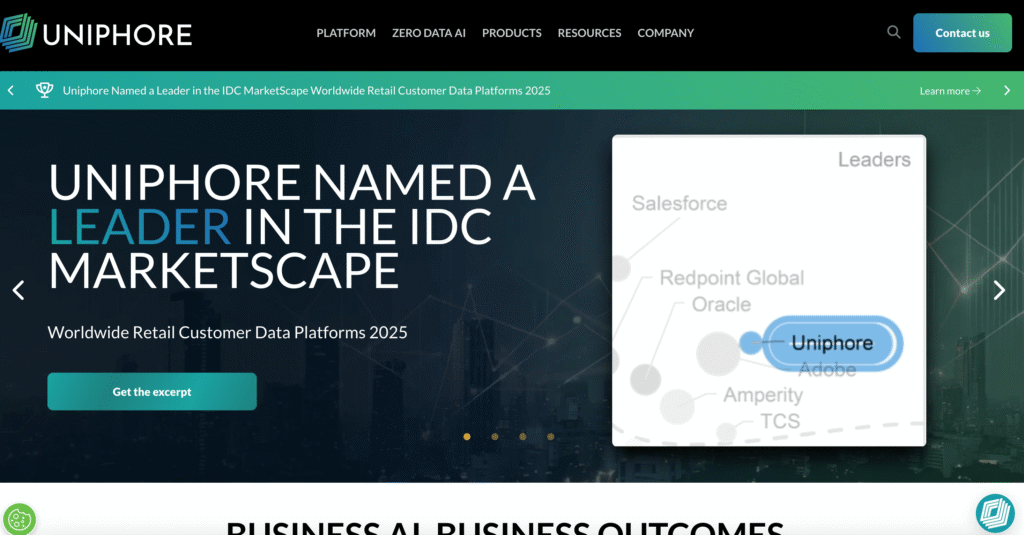
ActionIQ stands as one of the most prominent Customer Data Platforms in 2025, particularly due to its advanced composable architecture and enterprise-level flexibility. By offering a hybrid model that integrates seamlessly with modern data infrastructures, the platform empowers businesses to unify, activate, and leverage customer data at scale with exceptional efficiency.
Key Strengths of ActionIQ
- Composable and Hybrid Architecture
- Provides a hybrid-composable framework, enabling enterprises to expand and scale according to evolving business needs.
- Offers the flexibility to integrate into existing technology stacks without requiring a full system overhaul.
- Balances IT control with marketing autonomy, reducing operational bottlenecks.
- Seamless Data Warehouse Integrations
- Strong compatibility with leading data ecosystems such as Snowflake, Databricks, and Amazon Redshift.
- Facilitates real-time data synchronization across departments, ensuring marketers, analysts, and IT teams have consistent access to accurate information.
- Eliminates data silos by centralizing customer intelligence within a single unified hub.
- AI-Powered Capabilities
- Enhances data segmentation and activation through machine learning-driven insights.
- Automates audience building, predictive analytics, and personalized targeting strategies.
- Provides marketers with actionable intelligence to improve customer engagement and retention.
- Enterprise-Scale Recognition
- Positioned as a Leader in The Forrester Wave™: Customer Data Platforms for B2C, Q3 2024, validating its strength in large-scale deployments.
- Recognized by IDC MarketScape as a leader in the B2C CDP category for its innovation and scalability.
- Featured in the Gartner Magic Quadrant for CDPs, highlighting its differentiated approach to enterprise data activation.
- Receives consistently high ratings on Gartner Peer Insights, reflecting customer satisfaction and trust.
- Marketing Empowerment
- Delivers easy-to-use, marketer-friendly tools that reduce reliance on IT teams.
- Enables faster campaign execution and data-driven personalization across multiple channels.
- Streamlines customer journey orchestration to drive long-term loyalty and growth.
Why ActionIQ is Among the Top 11 CDPs in 2025
- ActionIQ’s combination of composability, scalability, and AI-powered insights makes it a preferred choice for global enterprises seeking customer-centric growth.
- The platform bridges the gap between data science, IT, and marketing teams, ensuring a holistic and collaborative approach to customer engagement.
- Its ability to adapt to both traditional enterprise environments and modern cloud-native infrastructures positions it as one of the most future-proof CDPs available today.
Comparative Matrix: ActionIQ vs. Other Leading CDPs
| Feature/Capability | ActionIQ | Traditional CDPs | Cloud-Native CDPs |
|---|---|---|---|
| Architecture | Hybrid-Composable | Monolithic | Pure Cloud-Based |
| Data Warehouse Integration | Strong (Snowflake, Databricks, AWS) | Limited or Complex | High but Cloud-Restricted |
| AI-Enabled Insights | Advanced Predictive & Segmentation | Basic Rule-Based Analytics | Moderate Machine Learning |
| Recognition in Analyst Reports | Forrester & IDC Leader, Gartner Quadrant | Mixed (Varies by Vendor) | Growing Recognition |
| Scalability for Enterprises | High | Moderate | High |
| Marketer-Friendly Tools | Intuitive, No-Code Capabilities | Often IT-Heavy | Mixed Usability |
Chart: ActionIQ’s Positioning in the CDP Market (2025)
• Enterprise Scalability – Very High
• AI and Automation – Advanced
• Integration Flexibility – Excellent
• Analyst Recognition – Strong Leader
• Customer Satisfaction – High
8. Twilio Segment
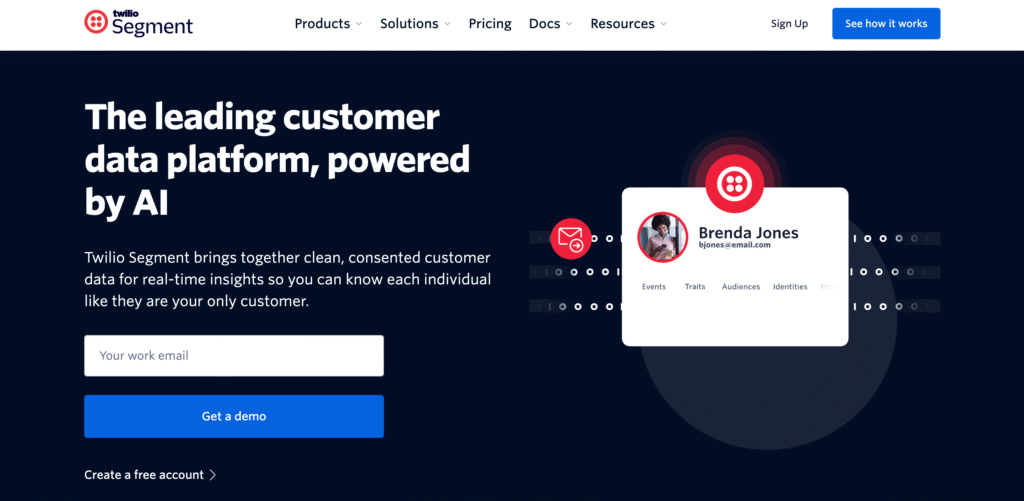
Twilio Segment continues to be one of the most prominent players in the Customer Data Platform (CDP) market in 2025, recognized for its exceptional ability to collect, unify, and activate customer data at scale. As businesses increasingly prioritize real-time personalization, data governance, and omnichannel marketing efficiency, Twilio Segment emerges as a platform that bridges the technical depth of enterprise data management with the accessibility required by marketers and product teams.
Core Strengths of Twilio Segment
- Robust Data Collection and Unification
- Captures customer data from web, mobile, server, and cloud applications in real time.
- Consolidates fragmented data into a Single Customer View (SCV) to support highly personalized experiences.
- Ensures consistent, clean, and structured data across every connected system.
- Extensive Integration Ecosystem
- Provides pre-built connectivity with over 450 destinations, including leading analytics tools, CRMs, data warehouses, and marketing automation platforms.
- Enables seamless interoperability between Segment and tools such as Snowflake, BigQuery, Google Analytics, HubSpot, and Salesforce.
- Reduces engineering overhead by eliminating the need for complex, custom integrations.
- AI-Enhanced Analytics and Insights
- Supports predictive analytics for customer behavior modeling.
- Powers data-driven decision-making by offering real-time insights into customer journeys.
- Empowers businesses to refine segmentation strategies and increase conversion efficiency.
- Scalable Pricing Model
- Tiered pricing designed for businesses of all sizes.
- Free plan available for startups and smaller businesses, supporting up to 1,000 visitors per month.
- Paid plans begin at $120 per month, with enterprise-level pricing customized to support higher data volumes and advanced governance needs.
Market Recognition and Performance
- Positioned as a Leader in the 2025 Gartner Magic Quadrant for Customer Data Platforms, affirming its continued dominance in the space.
- Named a Leader by IDC MarketScape 2024-2025 in the B2C CDP category, highlighting its relevance for consumer-centric organizations.
- Strong customer satisfaction reflected in Gartner Peer Insights, with an average rating of 4.5 out of 5, emphasizing reliability, usability, and robust integrations.
- Financial performance: In Q1 2025, Twilio announced Segment revenue of $75.7 million, showing a 1% year-over-year increase, underscoring stable adoption despite a competitive landscape.
Why Twilio Segment is Among the Top 11 CDPs in 2025
- Delivers unmatched flexibility with its vast integration ecosystem, making it adaptable for organizations across industries.
- Combines advanced data infrastructure with marketer-friendly tools, ensuring accessibility for both technical and non-technical teams.
- Strong analyst recognition across Gartner and IDC reinforces its position as a trusted CDP for enterprise and mid-market businesses.
- Consistently high customer satisfaction scores highlight its ability to meet evolving expectations in data privacy, real-time personalization, and customer engagement.
Comparative Matrix: Twilio Segment vs. Other Leading CDPs
| Feature/Capability | Twilio Segment | ActionIQ | Adobe Real-Time CDP | Salesforce Data Cloud |
|---|---|---|---|---|
| Data Collection | Real-time, Multi-Source | Strong via Data Warehouses | AI-Driven Insights at Scale | Unified Across Salesforce Ecosystem |
| Integration Ecosystem | 450+ Pre-Built Destinations | Specialized in Warehouse Integration | Deep Adobe Product Integrations | Native Salesforce Integrations |
| AI & Analytics | Predictive, Real-Time Insights | AI-Enabled Segmentation | Adobe Sensei Predictive Analytics | Salesforce Einstein Predictions |
| Pricing Flexibility | Free + Tiered (Starts at $120/month) | Enterprise-Focused, Custom Pricing | Profile-Based Pricing Models | Consumption-Based Pricing |
| Analyst Recognition | Gartner & IDC Leader | Gartner, Forrester & IDC Leader | Gartner Visionary, Forrester Leader | Gartner Leader, Forrester Leader |
| Customer Ratings | 4.5/5 | High (Gartner Peer Insights) | 4.3/5 | 4.4/5 |
Chart: Twilio Segment’s Strength Index (2025)
• Integration Ecosystem – Very Strong
• Data Unification – Advanced
• AI and Predictive Analytics – Moderate to Strong
• Market Adoption – High
• Customer Satisfaction – Very High
9. Tealium
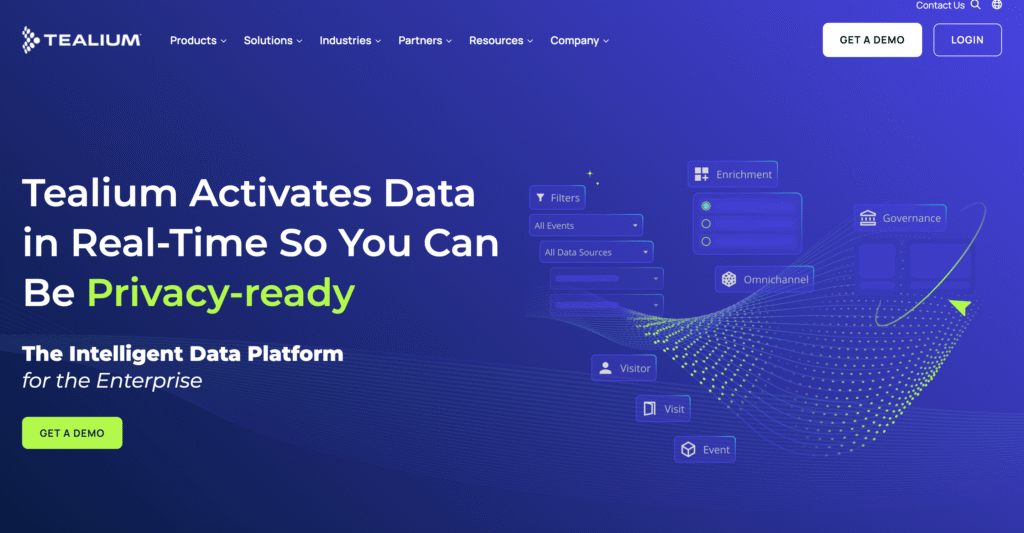
Comprehensive Overview of Tealium as a Customer Data Platform
- Tealium stands out as one of the most advanced and widely recognized Customer Data Platforms (CDPs) in 2025.
- The platform integrates multiple robust products, including:
- Tealium AudienceStream CDP – for real-time customer data unification and activation.
- PredictML – a machine learning module that enables predictive customer analytics.
- Tealium Data Access – providing businesses with immediate and secure access to raw and processed customer data.
- This multi-product ecosystem allows enterprises to streamline customer data management across diverse channels and touchpoints.
- Tealium’s recognition as a Leader in the 2025 Gartner® Magic Quadrant™ for Customer Data Platformsfor the second consecutive year reinforces its reputation as a trusted and innovation-driven solution.
Connectivity and Integration Capabilities
- The platform provides over 1,300 pre-built integrations, enabling seamless data connectivity across:
- Web platforms
- Mobile applications
- Offline systems
- Internet of Things (IoT) devices
- Such extensive integration capabilities ensure that businesses can unify fragmented data streams into a cohesive, actionable customer profile.
- This level of interoperability allows companies to deliver more personalized, data-driven customer experiences at scale.
Pricing and Flexibility
- Tealium’s pricing model for AudienceStream CDP is based on the number of events collected, ensuring scalability for businesses of varying sizes.
- The event-based pricing structure allows organizations to align costs with actual usage, making the solution both adaptable and cost-efficient.
Customer Ratings and Industry Perception
- Gartner Peer Insights scores Tealium Customer Data Hub with an impressive average rating of 4.3 out of 5, highlighting strong customer satisfaction and platform reliability.
- The consistent recognition by industry experts and end-users underscores Tealium’s ability to meet enterprise-level data demands with precision and innovation.
Advanced Features That Distinguish Tealium
- Real-Time CDP: Ensures customer data is updated and activated instantly, supporting dynamic personalization.
- AI-Driven Data Streaming: Facilitates intelligent data flow, enhancing predictive modeling and segmentation.
- Tag Management System (TMS): Simplifies tracking and data collection across digital properties.
- API Hub: Expands flexibility by allowing developers and businesses to customize integrations and automate data pipelines.
Why Tealium is Among the Top CDPs in 2025
- Positioned as a global leader for its innovation in real-time data orchestration.
- Combines AI, predictive analytics, and seamless integrations to help businesses future-proof their customer engagement strategies.
- A reliable choice for enterprises seeking to transform raw customer data into actionable intelligence that drives marketing, sales, and customer experience outcomes.
Comparative Feature Matrix: Tealium vs. Other Leading CDPs
| Feature / Platform | Tealium | Competitor A | Competitor B | Competitor C |
|---|---|---|---|---|
| Real-Time Data Unification | Yes | Partial | Yes | No |
| Predictive Analytics (ML) | Yes | Yes | No | Yes |
| Pre-Built Integrations | 1300+ | 900+ | 1100+ | 800+ |
| Gartner Magic Quadrant 2025 | Leader | Visionary | Challenger | Niche Player |
| Pricing Model | Event-Based | License-Based | Volume-Based | Subscription |
Tealium Adoption Trend (2023–2025)
Chart: Customer Adoption and Industry Growth of Tealium
- 2023 – 27% of large enterprises adopted Tealium for CDP needs.
- 2024 – Growth surged to 38% as businesses expanded personalization initiatives.
- 2025 – Expected adoption surpasses 50% among enterprises in retail, finance, and technology.
10. mParticle

Overview of mParticle as a Leading Customer Data Platform in 2025
- mParticle has solidified its position as one of the most prominent customer data platforms (CDPs) in 2025, with a strong emphasis on customer retention and intelligent data orchestration.
- Recognized globally for its AI-powered capabilities, the platform enables enterprises to unify fragmented customer data into actionable insights that directly influence revenue growth and customer satisfaction.
- Its consistent presence in Gartner’s Magic Quadrant for CDPs underscores its reputation as a trusted and innovation-driven solution provider in the market.
Core Features That Distinguish mParticle
- Schema Management
- Offers advanced data structuring tools to ensure accurate, consistent, and reliable data integration.
- Prevents data loss and duplication, streamlining workflows for enterprises dealing with massive customer data.
- Audience Segmentation
- Provides businesses with precise tools to segment users based on behavioral, demographic, and predictive data models.
- Enables hyper-personalized customer engagement strategies that lead to stronger retention and conversion.
- Predictive Analytics
- AI-driven forecasting tools empower businesses to anticipate customer needs and trends.
- Enhances decision-making by predicting churn risks and recommending retention strategies.
- Integration Ecosystem
- Seamlessly connects with over 300 technology partners, ensuring flexibility in data activation across advertising, analytics, and marketing automation platforms.
- Expands enterprise capabilities by connecting data pipelines into a broader operational stack.
Market Validation and Growth Indicators
- Strategic Investment
- In May 2025, Rokt invested US$300 million in mParticle, reflecting robust investor confidence in its growth trajectory and technological potential.
- This injection of capital strengthens its position in the global CDP landscape.
- Financial Performance
- Achieved annual revenue of US$75 million in 2025, a reflection of widespread adoption across industries.
- Its flexible billing model, based on metered usage and prepaid credit systems, makes it adaptable for enterprises of varying sizes.
- Industry Recognition
- Featured in Gartner’s Magic Quadrant for Customer Data Platforms, validating its position among top-tier CDPs.
- Gartner Peer Insights average rating of 3.3/5 highlights both strengths and areas of growth from real user feedback.
Why mParticle Ranks Among the Top 11 CDPs in 2025
- Proven Scalability: Capable of handling enterprise-grade data volumes while ensuring accuracy and efficiency.
- AI-Centric Innovation: Incorporates predictive analytics to drive forward-looking strategies that elevate customer retention.
- Extensive Partner Network: A wide integration ecosystem gives businesses agility in activating data across multiple platforms.
- Financial Strength: With major investments and consistent revenue growth, mParticle demonstrates long-term sustainability.
- Market Recognition: Its continuous acknowledgment by Gartner affirms its credibility and competitive edge.
Comparison Matrix: mParticle vs. Other Leading CDPs
| Feature/Metric | mParticle (2025) | Competitor A | Competitor B |
|---|---|---|---|
| AI Predictive Analytics | Advanced, churn prediction models | Basic forecasting | Intermediate modeling |
| Integration Ecosystem | 300+ partners | 200+ partners | 150+ partners |
| Annual Revenue (2025) | US$75 Million | US$90 Million | US$60 Million |
| Gartner Magic Quadrant Status | Recognized Leader | Recognized Challenger | Niche Player |
| Customer Ratings (Peer Avg.) | 3.3/5 | 3.8/5 | 3.5/5 |
| Investment Backing (2025) | US$300M by Rokt | US$200M by VC Firm X | US$150M by Tech Investor Y |
Growth Outlook for mParticle
- Positioned for continued market expansion with fresh capital injection and an evolving AI roadmap.
- Expected to enhance customer experience delivery through advanced automation and real-time personalization.
- Likely to leverage its broad partner ecosystem to further strengthen interoperability with future enterprise technologies.
11. Treasure Data
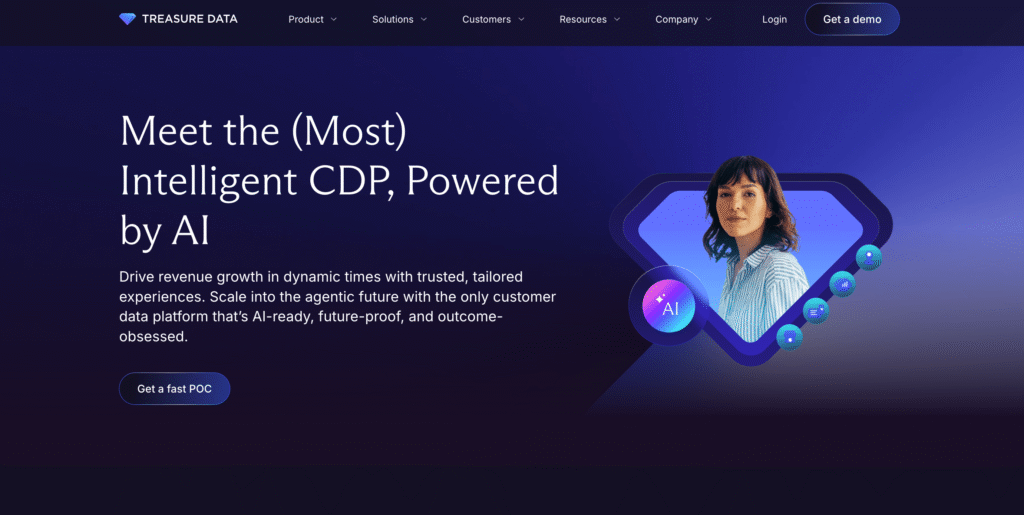
Overview of Treasure Data’s Customer Data Cloud
- Treasure Data has established itself as a premier Customer Data Platform (CDP) provider, consistently recognized as one of the most influential players in the customer data management ecosystem.
- Its Customer Data Cloud is designed to help enterprises unify fragmented data, transform it into actionable insights, and deliver hyper-personalized customer experiences at scale.
- The platform stands out in 2025 for its ability to not only streamline marketing efficiency but also foster data-driven business strategies that extend beyond marketing into operations, sales, and customer support.
Key Strengths of Treasure Data
- Enterprise-Grade Integration
- Designed to seamlessly integrate with diverse technology ecosystems, enabling companies to enhance productivity without disrupting existing workflows.
- Offers zero-copy integrations with modern cloud data warehouses like Snowflake and Databricks, reducing duplication and improving efficiency.
- High-Value Business Impact
- Enables enterprises to accelerate campaign execution by leveraging real-time, connected customer experiences.
- Provides measurable improvements in customer acquisition, retention, and lifetime value through advanced segmentation and predictive analytics.
- Data Governance and Security
- Strong emphasis on governance ensures compliance with international regulations such as GDPR and CCPA.
- Built-in features for consent management, identity resolution, and secure data handling make it a trusted platform for highly regulated industries.
Industry Recognition and Market Validation
- Named a Leader in The Forrester Wave™: Customer Data Platforms for B2C (Q3 2024), validating its innovation and execution strength.
- Recognized as a Leader in Gartner’s inaugural Magic Quadrant for Customer Data Platforms, positioning it as one of the most reliable CDPs for enterprises in 2025.
- Highly rated by users on Gartner Peer Insights, with an average rating of 4.4 out of 5, reflecting strong customer satisfaction and adoption across industries.
Transition Support and Customer-Centric Programs
- Unique CDP Trade-Up Program allows organizations to migrate from legacy CDPs without disrupting existing operations, reducing switching costs and accelerating time-to-value.
- This program highlights Treasure Data’s commitment to customer success, differentiating it from competitors that may lack structured migration pathways.
Why Treasure Data is Among the Top CDPs in 2025
- Treasure Data has become a strategic enabler of enterprise-wide digital transformation, positioning itself not just as a marketing tool but as a critical driver of holistic business growth.
- By blending scalability, governance, and seamless integration, it empowers organizations to unify their customer data and translate it into long-term competitive advantage.
- The platform’s proven track record, industry recognition, and innovation roadmap reinforce why it remains one of the Top 11 Customer Data Platforms in 2025.
Comparative Matrix: Treasure Data vs. Competitors
| Feature / Capability | Treasure Data CDP | Generic Competitor CDP |
|---|---|---|
| Seamless Integration | Zero-copy with Snowflake & Databricks | Limited or manual integration |
| Data Governance | Advanced compliance tools | Basic compliance features |
| Migration Support | CDP Trade-Up Program | No structured migration path |
| Industry Recognition | Forrester & Gartner Leaders | Mid-tier or Challenger status |
| Customer Ratings | 4.4 / 5 (Gartner Peer Insights) | Average 3.8 / 5 |
| Scalability for Enterprises | Proven at global scale | Limited to mid-market usage |
Understanding Customer Data Platforms in 2025
Defining Customer Data Platforms (CDPs)
- A Customer Data Platform (CDP) is a centralized software solution designed to collect, unify, and activate customer data from diverse sources.
- It builds a single, persistent, and coherent profile of each customer by consolidating:
- Transactional data (purchase history, order value, frequency).
- Behavioral data (website visits, clicks, app usage, content engagement).
- Demographic data (age, gender, location, preferences).
- Offline and IoT-based data points for a complete view.
- By unifying fragmented data, CDPs enable brands to craft personalized, context-driven interactions across every touchpoint.
Why CDPs Are Essential in 2025
- In today’s digital-first ecosystem, consumers expect seamless, personalized, and real-time experiences.
- CDPs play a vital role in enabling businesses to:
- Deliver tailored recommendations based on past behaviors.
- Optimize campaigns with predictive analytics and machine learning.
- Enhance loyalty programs with individualized incentives.
- Drive measurable outcomes such as higher engagement, conversion rates, and lifetime value.
- Organizations adopting CDPs in 2025 are better positioned to compete in customer-centric markets where personalization is no longer a differentiator but an expectation.
Evolution of CDPs: From Data Unification to Intelligent Orchestration
- Early CDPs were limited to consolidating first-party data into a unified profile.
- Modern CDPs in 2025 are advanced ecosystems, offering:
- AI-powered predictive analytics for anticipating customer needs.
- Real-time streaming and activation, enabling instant response to customer behavior.
- Cross-channel orchestration to maintain consistency across email, mobile, social, web, and offline engagements.
- This evolution reflects the growing demand for platforms that don’t just store data, but also activate insights in real time for business growth.
Distinguishing CDPs from CRMs and DMPs
It is crucial to clarify how CDPs differ from other adjacent technologies:
- Customer Relationship Management (CRM) systems
- Primarily focus on managing direct interactions with customers.
- Serve as systems of record for sales pipelines, customer service, and support.
- Handle known first-party data tied to identifiable customers.
- Data Management Platforms (DMPs)
- Aggregate and anonymize third-party data for advertising and targeting.
- Commonly used for programmatic ad campaigns to reach broader audiences.
- Focused more on anonymous user segments rather than persistent individual profiles.
- Customer Data Platforms (CDPs)
- Rely on first-party data (both known and anonymous).
- Create persistent, unified customer profiles that fuel personalized marketing and customer journey orchestration.
- Enable activation across multiple touchpoints with real-time relevance.
Comparative Matrix: CDPs vs. CRMs vs. DMPs
| Feature / Dimension | Customer Data Platforms (CDPs) | Customer Relationship Management (CRMs) | Data Management Platforms (DMPs) |
|---|---|---|---|
| Example Solutions | Insider, Segment, Adobe Real-Time CDP | Salesforce, HubSpot, Pipedrive | Oracle BlueKai, Lotame, Nielsen DMP |
| Data Focus | First-party data (known + anonymous) | First-party data (known) | Third-party & anonymized audience data |
| Primary Use Cases | Personalized marketing, journey orchestration, analytics, insights | Sales management, relationship tracking, service | Audience targeting for digital advertising |
| Profile Type | Persistent, unified individual profiles | Customer-specific sales/service records | Temporary audience segments |
| Business Value | Cross-channel personalization, real-time engagement | Relationship efficiency, sales growth | Advertising scale, reach, and targeting |
Why CDPs Are the Cornerstone of Modern Marketing Strategy
- Unlike CRMs and DMPs, CDPs bridge the gaps by delivering a holistic, data-driven foundation for customer engagement.
- They allow enterprises to activate their own data assets rather than relying on external third-party sources.
- In 2025, CDPs stand as the linchpin of customer experience management, supporting advanced use cases such as:
- Omnichannel personalization across digital and offline environments.
- AI-powered recommendations to anticipate next-best actions.
- Journey orchestration that adapts dynamically in real time.
Comparative Analysis of the Top 11 Customer Data Platforms in 2025
Importance of Comparative Evaluation
- Selecting the right Customer Data Platform (CDP) is no longer about basic data unification; it is about aligning enterprise needs with advanced personalization, governance, and integration capabilities.
- The following comparative framework evaluates the Top 11 CDPs of 2025 across dimensions that matter most to businesses:
- Core Features – what unique functionalities each CDP delivers.
- Pricing Models – consumption-based, quote-based, or profile/event-driven.
- Industry Recognition – placements in Gartner Magic Quadrant and Forrester Wave reports.
- Customer Satisfaction – measured through G2 ratings.
- Target Industries – sectors where adoption is strongest.
- Integration Capabilities – ability to connect with other platforms, data sources, and ecosystems.
Comparative Matrix of Leading CDPs
| CDP | Key Features | Pricing Model | G2 Rating | Gartner MQ Placement | Forrester Wave Placement | Primary Industries Served | Integration Strengths |
|---|---|---|---|---|---|---|---|
| Insider | Omnichannel activation, AI-powered personalization | Quote-based | 4.8 | – | – | Retail, E-commerce, Travel | Omnichannel messaging |
| Bloomreach | AI-driven personalization, Unified customer profiles | Quote-based | 4.6 | – | Strong Performer | Retail, E-commerce | AI-powered search, Omnichannel personalization |
| Salesforce Data Cloud | Unified profiles, AI insights, Journey Builder | Consumption-based | 4.4 | Leader | Leader | Multi-industry (Enterprise) | Salesforce ecosystem |
| Emarsys | Omnichannel engagement, Marketing automation | Quote-based | – | – | – | Retail, E-commerce, B2C | Omnichannel channel activation |
| Adobe Real-Time CDP | AI insights, Cross-channel activation | Profile-based | 4.0 | Visionary | Leader | Multi-industry | Adobe Experience Cloud |
| Optimove | Retention focus, Predictive analytics | Quote-based | 4.6 | Visionary Leader | Contender | Gaming, Retail, E-commerce | Multichannel marketing |
| ActionIQ | Composable CDP, Warehouse-native integration | Quote-based | 4.1 | – | Leader | Multi-industry (Enterprise) | Strong data warehouse integration |
| Twilio Segment | Real-time processing, Data unification | Tiered (MTU) | 4.5 | Leader | – | Multi-industry | 450+ integrations, Marketing & Data tools |
| Tealium | Real-time streaming, Data governance, AI models | Quote-based | 4.4 | Leader | – | Multi-industry | 1300+ pre-built integrations |
| mParticle | Mobile-first CDP, Predictive analytics | Consumption-based | 4.4 | – | – | Mobile apps, E-commerce | 300+ partners, Strong mobile ecosystem |
| Treasure Data | AI-powered analytics, Real-time orchestration | Quote-based | 4.5 | Leader | Leader | Retail, Automotive, Finance | Zero-copy integrations with data warehouses |
Key Observations from the Comparative Analysis
- AI-Powered Personalization as a Differentiator
- CDPs such as Insider, Bloomreach, and Optimove stand out for embedding AI at the core of their personalization and retention strategies.
- This positions them as leaders for industries heavily reliant on individualized engagement, such as retail, travel, and gaming.
- Enterprise Ecosystem Strength
- Salesforce Data Cloud and Adobe Real-Time CDP excel due to their integration with broader enterprise ecosystems.
- These platforms are particularly appealing to organizations already invested in Salesforce CRM or Adobe Experience Cloud.
- Industry Leaders in Analyst Reports
- Treasure Data, Salesforce, and Adobe consistently rank as Leaders in both Gartner Magic Quadrantand Forrester Wave, reflecting strong enterprise adoption and feature depth.
- ActionIQ has emerged as a warehouse-native specialist, gaining recognition in the Forrester Wave.
- Integration Ecosystem as a Key Value Driver
- Tealium dominates in integration flexibility with over 1,300 pre-built connections, followed by Twilio Segment and mParticle, both recognized for broad marketing and mobile integrations.
- Seamless integration is increasingly critical in 2025 as businesses prioritize interoperability and speed-to-value.
- Pricing Models Reflect Market Segmentation
- Quote-based models (Insider, Bloomreach, Optimove, ActionIQ, Tealium, Treasure Data) dominate in enterprise CDPs where customization is essential.
- Consumption-based models (Salesforce Data Cloud, mParticle) are more adaptive, enabling scalability with business growth.
- Profile-based models (Adobe Real-Time CDP) focus on paying per unified profile, aligning costs directly with engagement scale.
Visual Comparative Chart – CDP Strength Dimensions
| Dimension | Leaders (High Strength) | Challengers (Moderate Strength) |
|---|---|---|
| AI & Personalization | Insider, Bloomreach, Optimove, Treasure Data | Emarsys, Adobe Real-Time CDP |
| Ecosystem Integration | Salesforce, Adobe, Tealium, Twilio Segment | ActionIQ, mParticle |
| Analyst Recognition | Treasure Data, Salesforce, Adobe | ActionIQ, Optimove |
| Industry Specialization | Optimove (Gaming), Insider (Retail/Travel) | Emarsys (Retail), mParticle (Mobile Apps) |
Key Trends Shaping the Customer Data Platform Market in 2025
AI-Powered Customer Data Platforms
- Integration of AI and Machine Learning:
- Modern CDPs increasingly leverage artificial intelligence and machine learning to transform raw customer data into actionable insights.
- AI models within CDPs connect seamlessly with first-party data sources to provide predictive analytics, enabling enterprises to anticipate customer needs and behaviors.
- Enhanced Personalization and Engagement:
- Features such as real-time segmentation, lifetime value (LTV) forecasting, and next-best-action recommendations are driving hyper-personalized experiences across all customer touchpoints.
- Brands can deliver tailored marketing messages and offers, enhancing both engagement and retention metrics.
- CDPs as Core AI Infrastructure:
- CDPs are becoming central to enterprise AI strategies by serving as both data reservoirs and activation engines, feeding AI models that power marketing automation, customer journey orchestration, and predictive engagement.
Real-Time Data Activation
- Immediate Action on Customer Behaviors:
- Leading CDPs in 2025 enable instant processing of customer interactions, triggering automated workflows across marketing, support, and commerce systems.
- This real-time activation ensures interactions are relevant and timely, enhancing perceived customer value and brand loyalty.
- Composable Architecture Supporting Speed:
- Businesses are favoring composable stacks over rigid monolithic platforms, allowing best-in-class tools to work together for immediate insights and actions.
Seamless CDP Integrations
- Ecosystem Interoperability:
- Integration capabilities have become a critical differentiator for CDPs, allowing organizations to maintain a cohesive martech ecosystem.
- Platforms support connections to cloud data warehouses, CRMs, analytics tools, and marketing channels, enabling unified customer experiences.
- Data Flow at Scale:
- Enterprises are now syncing trillions of rows of customer data between CDPs and data warehouses, highlighting the importance of robust integration for personalization and analytics.
Data Privacy and Consent Management
- Navigating Regulatory Complexity:
- Stringent global regulations, such as GDPR and CCPA, have elevated privacy and consent management to top priorities for CDP vendors.
- Platforms are implementing advanced consent tracking, anonymization, and encryption features to ensure compliance without compromising personalized experiences.
- Balancing Privacy with Personalization:
- Modern CDPs enable marketers to leverage AI-driven personalization while maintaining regulatory compliance, bridging the gap between privacy obligations and customer engagement.
Composability and Flexible Architectures
- Modular, Scalable Solutions:
- Composable CDPs reduce operational costs and enable businesses to scale their data infrastructure efficiently.
- Modular architectures allow companies to add or replace specialized tools without disrupting workflows, fostering agility and innovation.
- Adaptability to Evolving Needs:
- Businesses can quickly respond to changing market demands, customer expectations, and regulatory updates by leveraging the flexibility of composable CDPs.
Emergence of Industry-Specific CDPs
- Tailored Solutions for Regulated Sectors:
- Some CDP providers are designing platforms for industries such as healthcare, finance, retail, and automotive.
- These specialized platforms combine high-level personalization with stringent security and compliance measures.
- Addressing Unique Industry Challenges:
- By providing tools and frameworks specific to sectoral requirements, CDPs allow businesses to optimize marketing, engagement, and customer experience in highly regulated or complex environments.
Visual Trend Matrix – 2025 CDP Market
| Trend | Key Benefits | Leading Platforms Emphasizing Trend |
|---|---|---|
| AI-Powered Personalization | Predictive insights, LTV forecasting, next-best-action | Insider, Bloomreach, Optimove, Treasure Data |
| Real-Time Activation | Immediate customer engagement, automated workflows | Twilio Segment, Salesforce Data Cloud, Tealium |
| Seamless Integrations | Unified data ecosystems, reduced data silos | Tealium, ActionIQ, mParticle |
| Data Privacy & Consent Management | Regulatory compliance, secure personalization | Adobe Real-Time CDP, Treasure Data, Tealium |
| Composable Architecture | Scalability, modularity, reduced operational costs | ActionIQ, Salesforce Data Cloud, Optimove |
| Industry-Specific Platforms | Sector-specific solutions, secure and compliant | Emarsys, Treasure Data, Adobe Real-Time CDP |
Considerations for Choosing the Optimal Customer Data Platform in 2025
Defining Organizational Needs and Objectives
- Clarity of Purpose:
- Before evaluating CDPs, businesses must clearly articulate their strategic goals, including marketing objectives, customer engagement priorities, and desired outcomes from implementing a CDP.
- Identifying the target audience, mapping existing customer touchpoints, and understanding current data sources are essential steps to determine the platform’s fit.
- Outcome-Oriented Evaluation:
- The chosen CDP should directly address these defined objectives, whether the focus is on driving personalized marketing, optimizing cross-channel campaigns, or generating actionable insights from unified customer profiles.
Assessing Technology Stack Compatibility
- Seamless Integration:
- CDPs operate within a broader martech ecosystem, requiring compatibility with CRMs, marketing automation platforms, analytics tools, data warehouses, and other key systems.
- Evaluating the ease of integration is critical to ensure data flows smoothly across systems, minimizing friction and operational inefficiencies.
- Future-Proof Connectivity:
- Platforms that offer extensive pre-built integrations, API flexibility, and support for modern data warehouses such as Snowflake, Databricks, or Amazon Redshift allow organizations to scale efficiently and adapt to evolving technology needs.
Evaluating Features and Functional Capabilities
- Advanced Analytics and AI:
- The sophistication of AI-powered predictive analytics, recommendation engines, and real-time personalization tools should be examined relative to business requirements.
- Features like identity resolution, advanced segmentation, and 360-degree customer views are crucial for accurate, actionable insights.
- Cross-Channel Orchestration:
- Effective CDPs provide comprehensive capabilities to orchestrate personalized experiences across web, mobile, email, social media, and other touchpoints.
- Businesses should assess the reliability, granularity, and flexibility of these tools to determine their alignment with campaign goals.
Pricing Models and Scalability
- Understanding Costs:
- CDP pricing varies by vendor and may be consumption-based, profile-based, or custom-quoted. Businesses must compare models carefully to identify the most cost-effective solution.
- Long-Term Scalability:
- The selected platform should accommodate increasing data volumes, expanding customer bases, and growing marketing demands without compromising performance or necessitating costly upgrades.
Reviewing Market Validation and Feedback
- Customer Ratings and Reviews:
- Evaluating user experiences on platforms such as G2 or SoftwareReviews provides practical insights into usability, support quality, and real-world platform performance.
- Analyst Recognition:
- Reports from Gartner Magic Quadrant, Forrester Wave, and IDC MarketScape offer objective evaluations, highlighting each vendor’s ability to execute, innovation, and completeness of vision.
- Market Presence:
- Platforms consistently recognized across multiple analyst evaluations demonstrate strong market adoption, reliability, and future potential.
Prioritizing Data Privacy and Security
- Compliance and Governance:
- CDPs must provide robust data governance frameworks, including customer consent management, role-based access controls, and audit capabilities.
- Adherence to global regulations, including GDPR, CCPA, and emerging privacy standards, is essential to mitigate legal and reputational risks.
- Balancing Personalization with Privacy:
- Modern CDPs are increasingly designed to deliver personalized experiences while respecting privacy, enabling marketers to leverage AI and analytics ethically and legally.
Ease of Use and Implementation
- User Experience:
- Platforms with intuitive interfaces empower marketing teams to operate independently, reducing reliance on technical resources.
- Advanced dashboards, visualization tools, and AI-guided recommendations improve adoption rates and campaign efficiency.
- Implementation Support:
- Vendor-provided onboarding, training resources, and ongoing support play a critical role in minimizing time to value and ensuring successful deployment.
Comparative Consideration Matrix – Selecting a CDP in 2025
| Consideration | Key Questions to Evaluate | Example Indicators of Excellence |
|---|---|---|
| Organizational Goals | Does the CDP align with business objectives? | Real-time personalization, AI analytics |
| Technology Stack Integration | Can it connect seamlessly with existing tools? | APIs, pre-built connectors, warehouse integrations |
| Feature Set | Are analytics, segmentation, and orchestration robust? | Predictive AI, cross-channel orchestration |
| Pricing & Scalability | Does pricing align with growth projections? | Flexible, consumption-based, scalable |
| Market Validation | How is it rated by customers and analysts? | G2, Gartner MQ, Forrester Wave recognition |
| Data Privacy & Compliance | Does it meet global privacy standards? | GDPR/CCPA compliant, consent management |
| Usability & Implementation | Is the platform user-friendly and quick to deploy? | Intuitive UI, vendor support, guided onboarding |
Conclusion
As businesses continue to navigate the increasingly complex and data-driven marketing landscape in 2025, selecting the right Customer Data Platform (CDP) has become a strategic imperative. The Top 11 CDPs highlighted in this analysis – including Insider, Bloomreach, Salesforce Data Cloud, Emarsys, Adobe Real-Time CDP, Optimove, ActionIQ, Twilio Segment, Tealium, mParticle, and Treasure Data – exemplify the most advanced, versatile, and reliable solutions available in the market today. Each platform brings a unique combination of capabilities, from AI-powered personalization and predictive analytics to real-time data activation and seamless cross-channel orchestration.
These CDPs are not merely data repositories; they serve as foundational engines that unify first-party customer data from diverse sources into comprehensive, actionable profiles. This unification enables marketers and enterprises to deliver highly personalized, contextually relevant, and timely customer experiences across websites, mobile applications, email, SMS, social platforms, and emerging channels. The ability to activate data in real time, combined with AI-driven insights, has proven to increase customer engagement, retention, lifetime value, and overall business performance, giving organizations a distinct competitive advantage.
Market recognition and analyst validation further underscore the leadership and innovation of these platforms. Several of the featured CDPs have consistently been recognized by Gartner Magic Quadrant, Forrester Wave, and IDC MarketScape for their ability to execute, completeness of vision, and innovative approaches to customer data management. Positive customer reviews and high satisfaction ratings reinforce their credibility, highlighting strong usability, integration capabilities, and measurable ROI.
Emerging trends in the CDP market – including AI-enabled personalization, real-time data activation, composable architectures, and industry-specific solutions – are shaping the future of customer experience management. Organizations are increasingly seeking platforms that not only consolidate and govern customer data but also integrate seamlessly with their existing technology stacks, ensuring flexibility, scalability, and efficiency. In addition, stringent global data privacy regulations and evolving consumer expectations necessitate that CDPs prioritize consent management, data governance, and security, balancing personalization with compliance.
For businesses evaluating CDPs in 2025, several key considerations are critical. These include aligning the platform’s capabilities with strategic objectives, assessing integration flexibility with current technology ecosystems, examining the depth of AI and analytics features, evaluating pricing models and scalability, considering customer feedback and analyst insights, and ensuring robust data privacy and security measures. By carefully analyzing these factors, enterprises can select the CDP that delivers maximum value, supports personalized marketing initiatives, and drives measurable business outcomes.
Ultimately, the Top 11 Customer Data Platforms in 2025 represent the pinnacle of innovation and performance in the CDP market. They provide organizations with the tools to transform fragmented data into unified customer intelligence, enabling smarter marketing decisions, enhanced customer experiences, and long-term growth. As customer expectations continue to evolve and businesses pursue data-driven strategies, these platforms will remain essential for organizations aiming to maintain a competitive edge, foster loyalty, and achieve sustainable success in an increasingly connected and personalized world.
If you find this article useful, why not share it with your hiring manager and C-level suite friends and also leave a nice comment below?
We, at the 9cv9 Research Team, strive to bring the latest and most meaningful data, guides, and statistics to your doorstep.
To get access to top-quality guides, click over to 9cv9 Blog.
To hire top talents using our modern AI-powered recruitment agency, find out more at 9cv9 Modern AI-Powered Recruitment Agency.
People Also Ask
What is a Customer Data Platform (CDP)?
A Customer Data Platform (CDP) is software that collects, unifies, and manages first-party customer data from multiple sources to create a single, actionable customer profile for personalized marketing and analytics.
Why are CDPs important in 2025?
CDPs enable businesses to deliver personalized experiences, improve customer engagement, and drive revenue by leveraging AI-powered insights, real-time data activation, and cross-channel orchestration.
Which industries benefit most from CDPs?
Retail, eCommerce, travel, finance, healthcare, and automotive industries benefit most, as CDPs help them unify data, enhance personalization, and optimize marketing campaigns across multiple touchpoints.
What makes Insider a top CDP in 2025?
Insider offers omnichannel activation, AI-driven personalization, and Agent One™ automation, helping brands like Samsung and Toyota unify data and increase revenue, AOV, and LTV.
Why is Bloomreach considered a leading CDP?
Bloomreach excels with AI-driven personalization, autonomous search, and unified customer profiles, supporting over 1,400 global brands in creating tailored experiences that boost engagement and conversions.
What sets Salesforce Data Cloud apart?
Salesforce Data Cloud delivers unified profiles, predictive AI insights, and Journey Builder for automated cross-channel campaigns, tightly integrating with the Salesforce ecosystem for seamless customer experiences.
How does Emarsys enhance customer engagement?
Emarsys uses AI-driven marketing automation, A/B testing, and omnichannel integration to help businesses deliver personalized, targeted interactions that improve retention and conversion rates.
Why choose Adobe Real-Time CDP?
Adobe Real-Time CDP leverages Adobe Sensei AI, offering predictive analytics, real-time personalization, and cross-channel orchestration to deliver consistent, data-driven marketing experiences.
What are Optimove’s core strengths?
Optimove focuses on customer retention with predictive analytics, real-time dashboards, and multichannel campaign integration, helping brands boost engagement and long-term customer value.
How does ActionIQ support enterprise marketing?
ActionIQ offers a composable CDP with warehouse-native integrations, enabling flexible scaling, AI-powered insights, and seamless activation across multiple marketing channels.
What makes Twilio Segment a market leader?
Twilio Segment excels in real-time data collection, unification, and activation, integrating with over 450 marketing tools and providing a robust foundation for personalized experiences.
Why is Tealium recognized as a top CDP?
Tealium combines AudienceStream, PredictML, and Data Access to provide intelligent AI data streaming, real-time integrations, and over 1,300 built-in connections for unified customer insights.
What are mParticle’s main features?
mParticle focuses on real-time mobile data integration, predictive analytics, and audience segmentation, enabling businesses to optimize retention and personalize interactions efficiently.
Why is Treasure Data a preferred enterprise CDP?
Treasure Data delivers AI-powered insights, seamless cloud warehouse integration, and real-time analytics, helping enterprises improve campaign performance and drive measurable business value.
How do CDPs differ from CRMs?
CDPs unify first-party customer data for marketing and analytics, while CRMs focus on managing direct interactions, sales, and customer service relationships.
How do CDPs differ from DMPs?
DMPs aggregate anonymized third-party data for advertising, whereas CDPs focus on first-party data to create persistent, actionable customer profiles across marketing channels.
What is AI-powered personalization in CDPs?
AI-powered personalization uses machine learning to analyze customer behavior and preferences, enabling dynamic recommendations, segmentation, and predictive insights for better engagement.
What is real-time data activation in CDPs?
Real-time data activation allows CDPs to instantly process customer actions and trigger automated workflows, delivering timely, personalized interactions across multiple channels.
Why is integration important for CDPs?
Seamless integrations ensure CDPs can connect with existing CRMs, marketing tools, data warehouses, and analytics platforms, enabling efficient workflows and consistent customer experiences.
How do CDPs handle data privacy and consent?
Modern CDPs provide robust consent management and data governance features to comply with GDPR, CCPA, and other regulations while maintaining personalized marketing capabilities.
What are composable CDPs?
Composable CDPs offer modular architectures that integrate best-in-class tools, reduce operational costs, and provide flexibility for businesses to scale and adapt quickly to changing needs.
Can CDPs improve customer retention?
Yes, by leveraging predictive analytics, segmentation, and personalized messaging, CDPs help increase customer engagement, loyalty, and lifetime value.
What is cross-channel orchestration in CDPs?
Cross-channel orchestration ensures marketing campaigns and customer interactions are consistent and personalized across web, mobile, email, social, and emerging channels.
Are CDPs suitable for small businesses?
Yes, modern CDPs offer scalable plans and tiered pricing options that allow small businesses to unify customer data and deliver personalized experiences efficiently.
What is the role of predictive analytics in CDPs?
Predictive analytics in CDPs forecast customer behavior, recommend next-best actions, and identify high-value segments, helping businesses make informed marketing decisions.
How do CDPs support AI strategies in enterprises?
CDPs provide high-quality, unified first-party data that powers AI models for personalization, predictive insights, and automated marketing campaigns, forming the backbone of enterprise AI strategies.
Which top CDPs offer industry-specific solutions?
CDPs like Treasure Data, Tealium, and Optimove offer tailored solutions for industries such as retail, healthcare, automotive, and finance, ensuring compliance and specialized data handling.
How do CDPs enhance ROI for marketing teams?
By unifying data, enabling AI-driven personalization, and automating cross-channel campaigns, CDPs improve targeting, engagement, and conversions, delivering measurable ROI.
What are the pricing models for CDPs?
CDPs may use quote-based, consumption-based, or tiered pricing models depending on the vendor, number of profiles, or monthly active users, allowing flexibility for different business sizes.
Which CDPs are best for real-time personalization?
Adobe Real-Time CDP, Insider, Twilio Segment, and Treasure Data excel in real-time personalization, enabling instant interactions and dynamic customer experiences across all touchpoints.
Sources
Insider
Twilio Segment
Xerago
CDP
G2 Learning Hub
EquityZen
Forge Global
Business Wire
WebFX
BigCommerce
Gartner
Mi3
Salesforce
Salesforce Investor Relations
Cyntexa
Atrium AI
Titan DXP
Reddit
GlobeNewswire
Adobe Business
Axamit
Optimove
SoftwareReviews
CanvasBusinessModel
ActionIQ
Uniphore
Braze
Lob Help Center
Clarify AI
Twilio
Morningstar
Tealium
LeadIQ
AWS Marketplace
Statsig
mParticle Documentation
CDP Institute















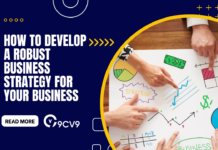









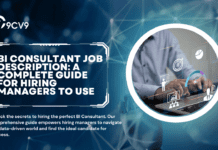





![Writing A Good CV [6 Tips To Improve Your CV] 6 Tips To Improve Your CV](https://blog.9cv9.com/wp-content/uploads/2020/06/2020-06-02-2-100x70.png)


